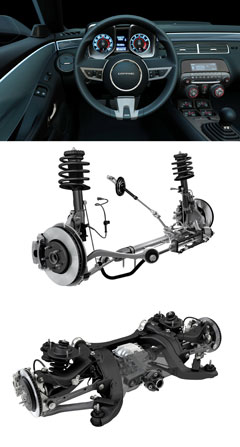Make / Model Search
News - General MotorsKeeping Camaro coolChev: Born-again Camaro started life as a VE Commodore. Holden toiled to stay true to the concept Camaro’s transition to production reality23 Jul 2008 GENERAL MOTORS’ unveiling of the production-ready version of the Chevrolet Camaro ‘pony car’ this week in America and in Melbourne has shone light on Holden’s massive influence and involvement in the project. Although based on the Zeta platform that underpins the VE Commodore, the 2009 Camaro has required wholesale engineering changes by Holden in order to meet GM’s requirements. These include the integration of the VE’s independent rear suspension system in a car that is going to start from around US$22,000 (A$22,550), which may include cutting some of the cost out of the set-up. Meanwhile, to accommodate the lower seating positions necessary in a sports car or coupe/convertible, the Camaro’s rear floorpan has seen extensive modifications to the Zeta structure compared to Commodore. Holden also had to work at lowering of the front suspension components to fit into the low bonnet line that the style-driven Camaro demands. This involved the implementation of an elongated ‘dash to axle’ (GM speak for the measurement of the cut-line of the front door to the front wheel), to give the Camaro its sporty “long hood look” that is central to a pony car’s appeal, creating the smallest of the three Zeta platform modules (VE is the middle one while the WM Statesman/Caprice represents the longest). “The shortest chassis would make for an excellent smaller sedan or coupe,” quipped one GM insider, adding: “It’s really kind of a coupe front-end we even talked about using it on a very stylish sedan, with a long nose like a Jaguar’s or a Maserati you could use it in a lot of ways. It’s good to have it in the tool box.”  Top to bottom: Camaro interior, front suspension, rear suspension. Top to bottom: Camaro interior, front suspension, rear suspension.Other chassis-related changes include the ability to take on the Camaro’s larger wheel and tyre packages (the show cars measured up to an unfeasible 20-inch set). The latter, along with the independent rear suspension, created headaches for Holden’s engineers who were trying to keep weight from ballooning upwards. In the end, both items add about 40kg and 60kg to the Camaro’s mass, but GM has still managed to keep the base V6 car under the weight under that of a 1969 Camaro with a V8 – and this is in spite of all the additional safety and convenience features like airbags. One major point of difference between the 2006 Detroit show-stealing Camaro Concept and the one US consumers will be able to buy next March is the addition of a ‘B’ pillar. According to GM’s Global Vehicle Line Executive, Gene Stefanyshyn, this was unavoidable if the production car is to meet current and future crash-test requirements. On the other hand, form beats function when it comes to pedestrian impact safety. GM avoided having to raise the Camaro’s bonnet line high enough to meet European pedestrian impact legislation by promising not to sell more than 5000 units in Europe every year. According to one GM executive, lifting the bonnet line would have destroyed much of the muscle car’s stylistic purity and appeal. Yet achieving the same proportions as the concept car (itself an interpretation of the 1969 Chevy Camaro SS), while meeting all the modern rules and regulations, has been the highest mountain to climb for the production Camaro’s exterior design manager, Australian Peter Hughes. “The work to get the (production Camaro) looking even half like the concept car was a huge challenge,” he explained. “The proportions of the show car are stunning, but you can’t live with them – I mean, the thing came with 23-inch wheels and the roof that is slammed to the max they add to the car’s stance and aura that people fell in love with. “The challenge for us was to take that unbelievable look and try to capture it in a production car – that was the really had bit. Hours of changing lines… to make it look as tough as that show car was.” Mr Hughes added that the engineering team helped out with achieving this by doing things like compressing the roof lining and moving header rails in order to achieve the Camaro’s desired look. “When you look at how big the body is and how small that glass is, it’s pretty spectacular for a production car,” he said. Ultimately, GM’s top brass are said to be very happy with the result of Holden’s Melbourne-based team. “We had the coupe and the concept together, and a lot of people couldn’t tell the difference – from a visual perspective,” says Camaro’s interior design manager, Aaron Denewith. Mr Denewith said that one of the interior’s biggest hurdles was to create a high instrument panel and a dished steering wheel, using a modern car base that offered the exact opposite. “It’s one of those things that is different from the norm. Back in ’69 that’s all there was… nothing but high dash panels and dished steering wheels,” he said. Both designers agreed that if the Camaro did not have a dished steering wheel, then it would be less convincing as a muscle car. “Our car has gone further and has actually become a bit more refined than the show car – in its development for the exterior and interior,” Mr Hughes believes. Mr Stefanyshyn backed his Holden colleague up by adding: “This vehicle exhibits the depth and capability of design and engineering teams here in Australia and I am incredibly proud of what they achieved to help make this vehicle a reality.” Nevertheless, despite Holden’s involvement, the Camaro is still going to be the ‘All American Pony Car.’ And that means that its distinct styling guarantees that it will only be marketed as a Chevrolet. This is why one GM insider told GoAuto that there is “no way” that Chevrolet would allow the Camaro to be rebadged as anything else – including a Holden. Read more:Ponies for peanutsCamaro decision coming |
Click to shareGeneral Motors articlesMotor industry news |









Facebook Twitter Instagram